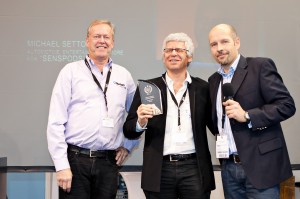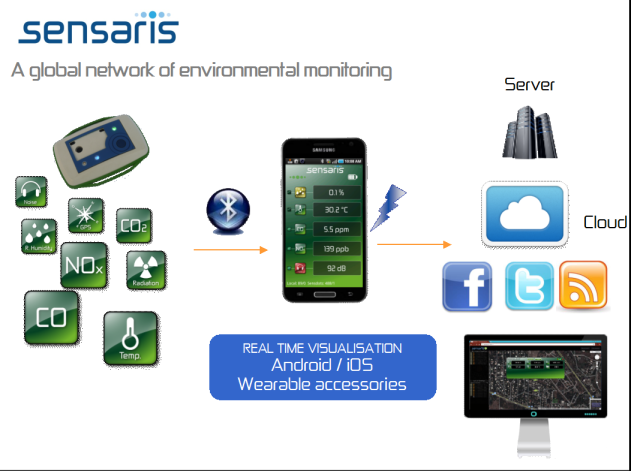Using Senspods, it is now easier than ever to check indoor environmental quality.
The new Senspods were developed and trialed through a grant from the Eco Energies Innov funding program Eco Innov focusing on home energy savings.
Studies at Coventry University clearly showed that monitoring CO2, temperature, humidity and amount of light is also useful for home energy profiling and to better understand where gains can be made towards passive homes.( Coventry Passive Homes ).
The data can be visualized in real time using mobile phones or data sent to the cloud can be to compare the environmental quality of different homes. Continue reading
Category Archives: Environment Tech Info
Sensaris releases its Sens2Cloud API for Internet of Things applications.
To answer the request from developers wanting to integrate Senspod data into their own applications, we are releasing our first version of the Sens2Cloud API. The principles that guided us were ease of use, flexibility to adapt to new types of sensors, and flexible controls.
Dominique Guinard (with Ion and Mayer) highlighted the advantages of using REST for wireless sensor networks in this publication:
He concludes “Participants identied that RESTful Web services represent the most straightforward and simple way of achieving a global network of smart things because RESTful Web services seamlessly integrate with the Web.”
Now that the framework is released, the next Senspods will all follow the same data format, but since we’ve got already 15 Senspods, you have a busy summer ahead of you.
In this manual, you will find how to deal with:
Authentication
Query format
Returned values
Senspod’s functions
Get the Senspod’s frame data units
Extract the last X Senspod’s frames
Obtain Senspod’s frames between two dates
Have fun.
Sensaris moves sensor data to watch type platforms.
After the success of Senspods used for the “Montre verte” and the” Copenhagen wheel” projects, we wanted to build services based on information shown in real time on wearable platforms.
We started with the Sony Ericsson Live View and Android based phones.The result is shown below:
Senspods’ data can be provided as RSS feeds, therefore very simple RSS readers can display information on wearable devices, so developers can let their imagination run wild for new applications based on sensor data.
Since we can now also stream Senspod data to iPhone, our next development will be to use the amazing Pebble Watch !!
Stay tuned and contact us if you are interested to become one of the early adopters.
Finding out about your city’s carbon footprint.
Picarro (http://www.picarro.com) produces highly sensitive and accurate gas sensing instruments which rely on a technology called cavity ring down spectroscopy. The company published a fascinating methodology to determine actual CO2 emissions from a city.This was performed during the Davos summit.You can see the results of such visualisation here:
CO2 emissions over Davos
Actual methodology is detailed in this publication from Picarro:
CityCarbon_Science_and_Data
This graph compares the emissions for cities of various scales and built around different economies: Davos, Seoul and Tokyo.
Even though sensors used for participatory sensing such as Senspods are not laboratory instruments, once properly calibrated and used by citizens to cover city wide areas, there is no reason why mobile sensors could not be used to quickly build a global environmental network.
Winner for the Automotive and Entertainment category in the Bluetooth Innovation World Cup 2011 !
Yesterday was a very special day as we received in Munich an award for the Bluetooth Worldwide Innovation Cup in the category “Automotive, entertainment and other” .
This has a special meaning for us as it validates our vision to build a global network of environmental monitoring sensors for citizens. Mobile phones are personal devices but our environment is a shared responsibility and concern. The Senspod family is growing quickly and there will be exciting announcements in the near future so stay tuned.
We thank the Bluetooth SIG and the members of the jury for this recognition, and for those of you that could not attend the ceremony at ISPO, here is our presentation.
Sensaris software lands on Android Market.
After beta tests in 6 countries (out of 18 countries where Senspods are used), we are now releasing Senspod App.
Starting with EcoSense, you can now download software directly from the Android Market, install it on your Android devices and start making a difference for the environment in your city.
Simple steps:
- Scan the QR code,
- select install,
- launch the app,
- select your Senspod and enter 1111 for pairing.
Send your friends the web address to see your data live. You are done.
Current record is 1:48 (and that was even without any warm-up whatsoever).Can you top that ??
Sensaris is a finalist in the 2011 Bluetooth Innovation World Cup.
We are happy to announce that Sensaris has been selected as part of the 3 finalists in the category “Automotive, Entertainment & More using Bluetooth low energy technology”.
Senspods qualification for this competition confirms our belief that Bluetooth is the leading enabling technology for Internet of Things applications.
This is definitely the right category for Senspods as we showed their use for the IBM Greenhaviour project where Senspods were mounted on a driverless car, and it fits with the entertainment part as well since we initially developed the “Montre Verte” concept and have now taken it to the next level using wearable accessories.
The pervasiveness of mobile phones with Bluetooth radios is both an advantage and a challenge.It is an advantage in terms of power consumption and low gateway costs (any mobile phone with Bluetooth will do). It is a challenge because our software platform needs to work similarly on Nokia Series 40 phones, Android phones from version 1.6 to 2.3 or iOS devices.
Our recent demo in Mumbai definitely showed that crowdsourcing is the way forward for improved sustainability. No matter what the outcome of the competition is, we will be increasingly focusing on wide scale applications in the coming year. Stay tuned !
Sensaris releases its geolocated Geiger counter.
Sensaris adds radiation monitoring to its Senspod platform. Recently some areas with high radiation levels have been detected by citizens in Japan and it is clear that a large number of Geiger counter is necessary to keep track of safe areas over time.
The RemPod has been designed to provide such a service to citizens and municipalities as it measures alpha, beta and gamma radiation and GPS coordinates, and either stores the data on a memory card or displays the values in real time on mobile phones via Bluetooth transmission.
Users can view the data in real time on their phones and also share the data using geosocial networking tools. The integration with mapping and social networks enables rapid sharing of safe areas; people wanting to know more about the safety of their immediate area can access the web based visualization interface using any device with a web browser.
For fast deployment several devices can also be simultaneously connected to WiFi or 3G networks. Since RemPods are also designed to store measurements in a built in microSD memory card, they can record data even in conditions with no network access such as ships at sea for example. The sensors will also be valuable tools to monitor soil decontamination and to then keep track of the evolution around storage facilities.
“Safecast in Japan paved the way for citizen centric radiation monitoring but we wanted to broaden compatibility with smartphones and simplify data sharing via social networks. We are very pleased that the initial testing of RemPods by daily users in 5 countries has been successfully completed both from an accuracy and a software ease of use point of view. Senspods are our first building block of Social, local, mobile environment monitoring.” declared Michaël Setton, founder and CEO of Sensaris.
Qatar University Wireless Innovation Center plans air quality sensor network.
The Qatar University Wireless Innovations Centre (QUWIC) at the Qatar Science and Technology Park has unveiled two new systems that they say will deal with some of the significant logistics and systems management issues currently facing Qatari institutions.
Using its new Labeeb data processing system, QUWIC has launched Masarak, a comprehensive solution to provide real-time and historic traffic information in Qatar, and a user interface that will support services and applications using this information to address the needs of three market segments: government entities, enterprises, and consumers.
Users can access these systems through mobile device applications, web applications, voice, SMS and broadcast, and will allow users to monitor traffic congestion on an interactive map, as well as get directions between locations that factor in traffic flow, ease of use and distance. The system can monitor data from vehicles such as Mowasalat taxis and buses, and will also integrate data from cameras. QUWIC officials say that the system promises to assist with traffic congestion and monitoring, vehicle tracking, trip planning, dispatching and intelligent fleet management.
Users will be able to monitor air quality in real time on their mobile device According to QUWIC officials, strategic partnerships have been formed to create comprehensive business ‘eco-system’, including the Ministry of Municipality and Urban Planning, the Ministry of Interior and Traffic Department, Mowasalat, Qtel, Qatar University, and Qatar Foundation.
QUWIC has also partnered with Qatar Foundation’s HSSE Department, the Qatar Energy and Environment Research Institute and the Ministry of Environment to design and build its Qatar Air Pollution Surveillance System (QAPSS).
The system will use the Labeeb data processing technology to integrate data from air monitoring sensors that are set to be installed along Qatar’s roads with data from larger air quality monitoring stations at Qatar University, Education City, the Ministry of Environment and other locations around Doha.
QUWIC officials said that additional sensors can be installed at construction sites, smart cities, sports facilities and educational institutions as needed.
These stations will be monitoring levels of particulate matter, oxygen, carbon monoxide, carbon dioxide, nitrogen oxide, and sulphur oxide, as well as other atmospheric conditions such as temperature and humidity, all of which have an effect on human health.
QAPSS will help build a bank of historical and real time environmental data that will provide a clear map of air quality conditions around Doha, which will allow experts to advise on possible safety measures and government policies.
Users will also be able to monitor air quality conditions in real time on their mobile device through an application designed by QUWIC’s Mobile App Development Centre. QUWIC officials said that these systems were purpose built, and will continue to evolve to meet new challenges and tackle new problems as they come up. They are in a position to be flexible and adaptive, as these solutions have been built in-house and have not been brought in from institutions outside of Qatar.
Global map of environmental sensing projects.
We have been working on this topic for several years and thought it would be beneficial to gather and share in one location technical information pertaining to wireless sensors for urban environmental monitoring.
Here is a map of the projects/studies we are aware of, and we will constantly update it of course. If you are aware of other projects that we should add to this list, please send us information.
View Sensaris Environmental monitoring sensor network research in a larger map
air pollution based on geosensor network Korea
India bus GPRS GPS Air sensing
INTEL COMMON SENSE SAN FRANCISCO










